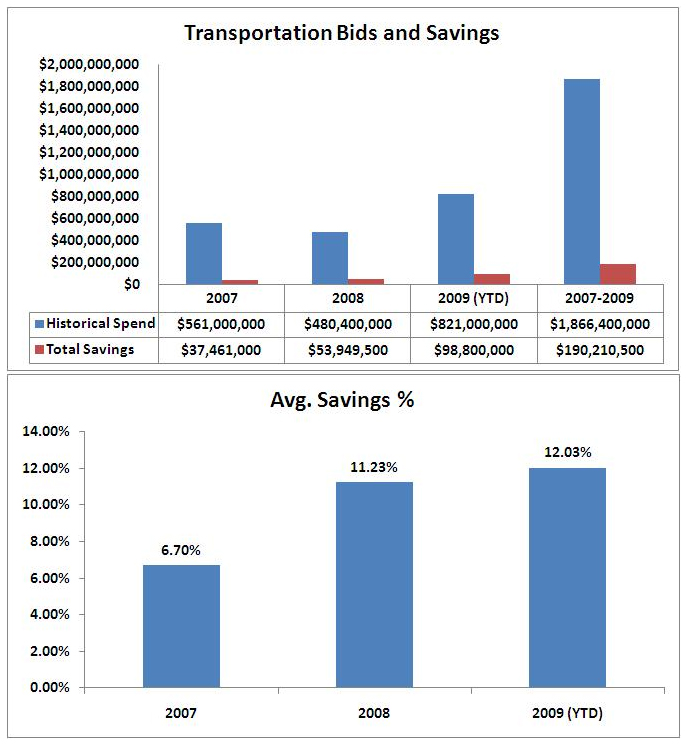Network Analysis – The Lynchpin of Successful Transportation Bid Preparation

Network alignment is the true power behind a successful transportation procurement event and getting the right carrier assigned to the right lane is the goal.
In my experience working with shippers to create and execute bids, I have yet to present a transportation network and spend to a shipper and have them say, “That’s exactly what I thought it was.”
The shipper is always surprised by their spend, carriers used, spikes and valleys in volumes, and by the shifting origin-destination pairs.
So why is this important? During the bidding process, the execution of the bid receives a lot of focus. The optimization of the results receives even more focus (“How much am I going to save?”). Slightly less focus goes into actually executing the awards. This, of course, is essential if the shipper is to realize the calculated savings.
However, I would argue that the single most important piece of a transportation bid is accurately forecasting the lane network, and accurately communicating the lanes and lane requirements to the carriers.
While execution of the award is essential to realizing the calculated savings, a poorly forecasted network is impossible to execute. When load planners are not executing to the routing guide determined by the bid, it is often not an execution problem but a symptom of an unrealistic award.
Correctly forecasting a lane network is not a trivial task. This is usually the driving force behind prolonged bidding events. To address the length of bidding events, software companies have created tools to aid in the process of bid generation. A bidding tool that is fully integrated with the execution tool can help to reduce the analysis effort, and the automated lane and shipment queries to aid in bid creation can also be a real time saver.

However, this automation can also add to the misconception that the network can be easily defined. If the first step of a bidding process is a query of existing lane usage, and an automatically created bid, the shipper believes they are nearly complete in defining their network. The risk is a poorly forecasted and inaccurate network. A shipment history (and/or a lane usage analysis) is only a starting point to defining a transportation network. The goal is not a representation of your past transportation network, but a forecast of your future transportation network.
As an example, consider a lane in which Carrier A hauled the freight for the first six months of the year at $1000/load. The shipper then switches to Carrier B for the second half of the year at $800/load. A straight calculation yields an historical cost over the year of $900/load (assuming volume is constant). Using $900/load as the historical cost would cause the bidding tool to perceive a bid of $850 as a $50/load savings, when in reality, it is a $50/load increase.
In this regard, historical cost should not be defined as “what did I pay historically?”, but as “what can I expect to continue to pay if I don’t bid?” The same basic concept can be applied to all attributes of the lanes: day-of-week analysis, one-time events, opening of new DCs, temporary and/or permanent sourcing changes, new product lines, expected growth, and so on. All of these things need to be fully understood to accurately define and forecast a transportation network.
Network alignment is the true power behind a successful transportation procurement event. Getting the right carrier assigned to the right lane is the goal. Simply put, a carrier with empty trucks in the areas of your pickups, and a carrier needing empty trucks in the areas of your deliveries can not only give you a better price, but will also give you better service.
All transportation networks change over time. Typically, a carrier’s network changes more rapidly than a shipper’s network. What was a good lane for a carrier last year is not necessarily a good lane for the same carrier this year. This is why regular bidding events are necessary, regardless of market conditions, to keep constantly shifting networks aligned.
Alignment is not possible if the network is not accurately forecasted and represented.
About the Author

Bob Jarvis is a Director at Manhattan Associates. Bob has over 20 years Supply Chain experience, including over 13 years working with both carriers and shippers at Manhattan Associates. Bob holds a Bachelors from Skidmore College, and a Masters from Rensselaer Polytechnic Institute.
Source: LogisticsViewpoints
Article Topics
Manhattan Associates News & Resources
Agility Robotics and Manhattan Associates partner to bring AI-powered humanoid robots into warehouses Unpacking the future of warehouse talent Inside Cardinal Health at-Home: Getting the right products out the door at the right time Tightening up on inventories enVista joins Manhattan Associates’ partner program as Gold Partner How WES is changing the game for fulfillment centers Labor Management as a dynamic tool More Manhattan AssociatesLatest in Transportation
Baltimore Bridge Collapse: Impact on Freight Navigating Amazon Logistics’ Growth Shakes Up Shipping Industry in 2023 Nissan Channels Tesla With Its Latest Manufacturing Process Why are Diesel Prices Climbing Back Over $4 a Gallon? Luxury Car Brands in Limbo After Chinese Company Violates Labor Laws The Three Biggest Challenges Facing Shippers and Carriers in 2024 Supply Chain Stability Index: “Tremendous Improvement” in 2023 More Transportation













